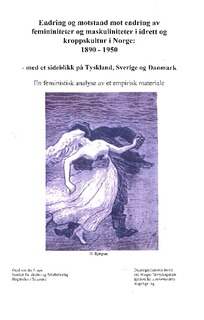Endring og motstand mot endring av femininiteter og maskuliniteter i idrett og kroppskultur i Norge 1890-1950 - med et sideblikk på Tyskland, Sverige og Danmark : en feministisk analyse av et empirisk materiale
Doctoral thesis, Peer reviewed
Permanent lenke
http://hdl.handle.net/11250/2437820Utgivelsesdato
1997Metadata
Vis full innførselSamlinger
Sammendrag
The title is "Changing Fernininities and Masculinities in Sport and Body Cultures in Norway: 1890-1950 - with a Sideglance to Germany, Sweden and Denmark. A Feminist Analysis of an empirical Material" . Focus is on the construction of gender in handball, track and field, gymnasties, skiing, skating, riding, swimming, tennis, fencing, rowing and marching. The following material is analysed from 1890 till 1950: National newspapers, sports magazines, womens magazines, magazines of local sports clubs in Oslo and Akershus, board meetings of different organized sports and those of Oslo and Akershus, the committee of doctors, central committees of women and also in different sports federations, the Journal of Norwegian Medical Association, German sports periodicals in track and field and gymnastics in addition to written rules of handlball in Norway, Germany, Sweden and Denmark. 15 former athletes, leaders and coaches are interviewed, 14 of which in a qualitative manner. The theoretical perspectives are hegemonic masculinity with a feminist emphasis, Bourdieu' s terms habitus and field in addition to a feminist focus on the body. A social-semiotic analysis of texts are used where metaphors and symbols are in focus. The relation sex-gender is deconstructed in a creative manner and moderately reconstruced in the logics of modernity with a postmodern "twist". Construction of gender in different sports fields and cultures are stories of variations, some contradictions, but with clearcut structures of the males as the "natural" sporting bodies in all sports except handball. Here female athletes might be interpreted as the gender of first order, whereas the males were the leaders, coaches and referees. The gender of the males were, however, never featured as "destiny" in handball, because their bodies were never ridiculed in the press as those of the females were for example in track and field, skiing and marching. Further, female bodies in gymnastics, swimming and riding were never depicted as "destiny" . The construction of the female gender as the second sex-gender or as subordinated is not regarded as a priori category but formed and forming in different periods and contexts.
